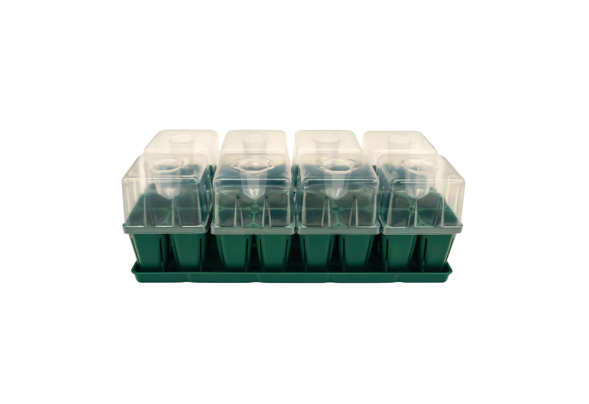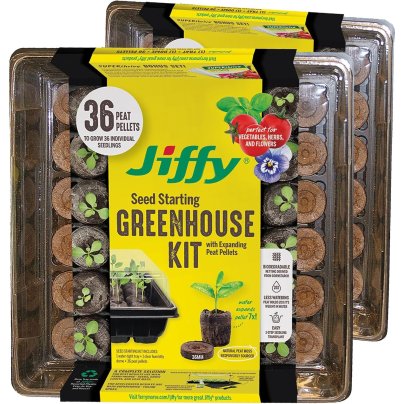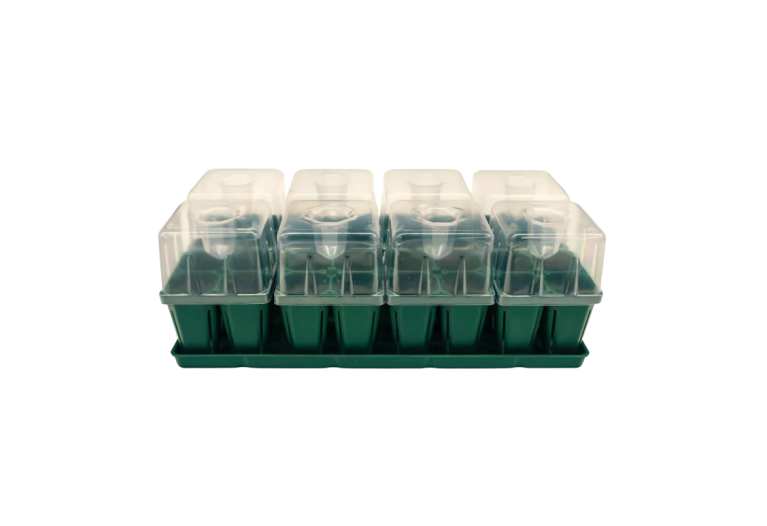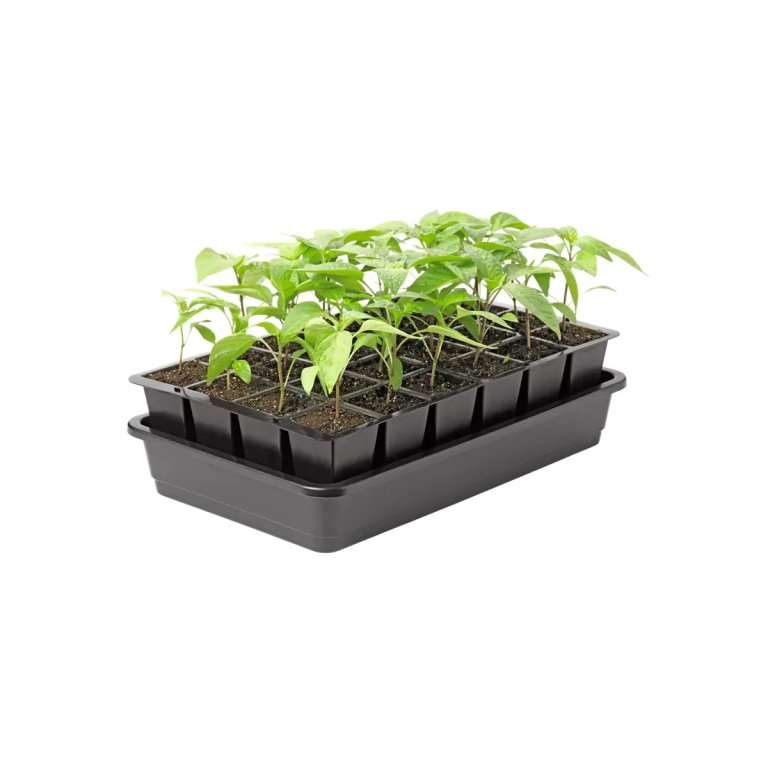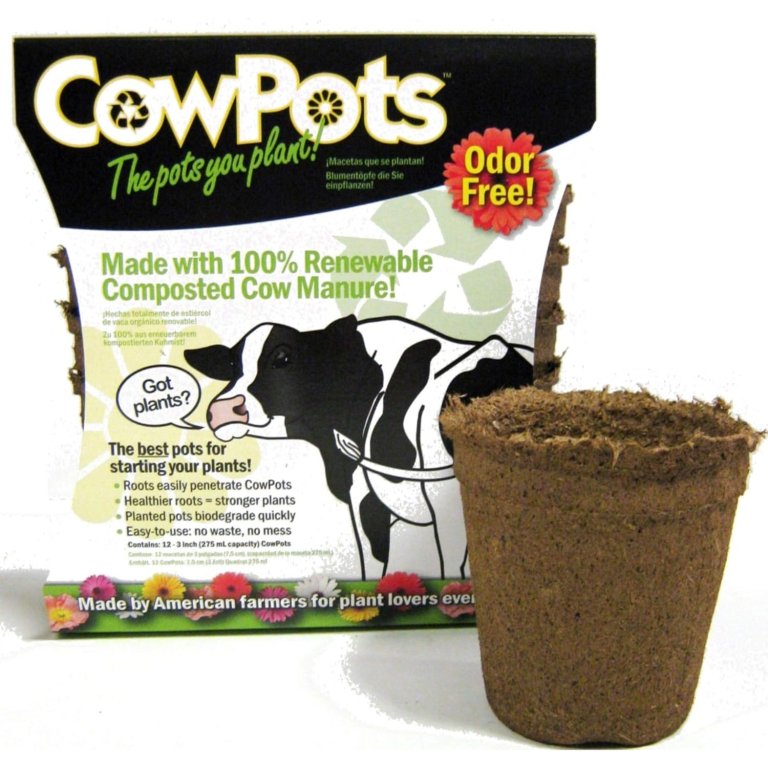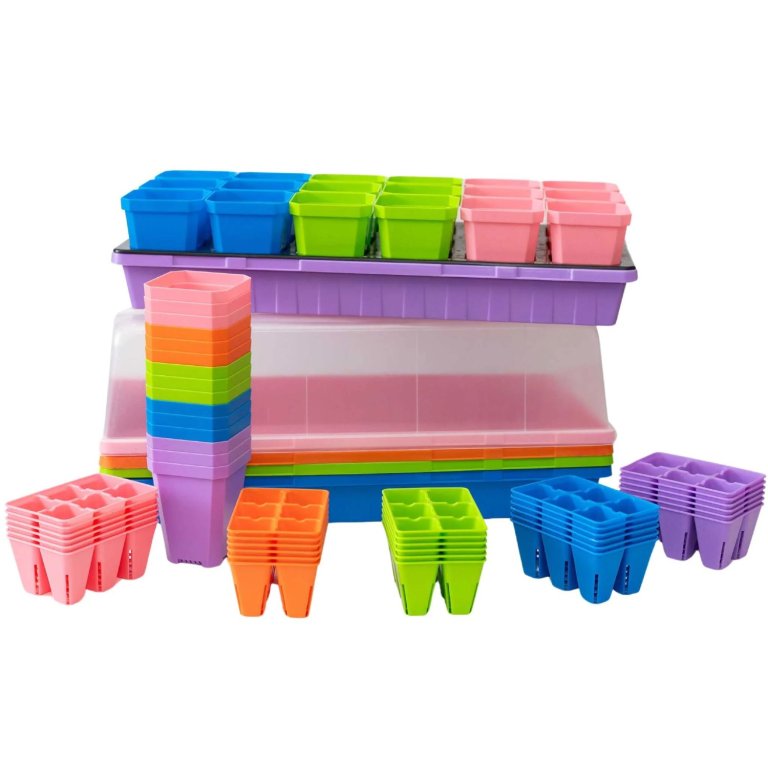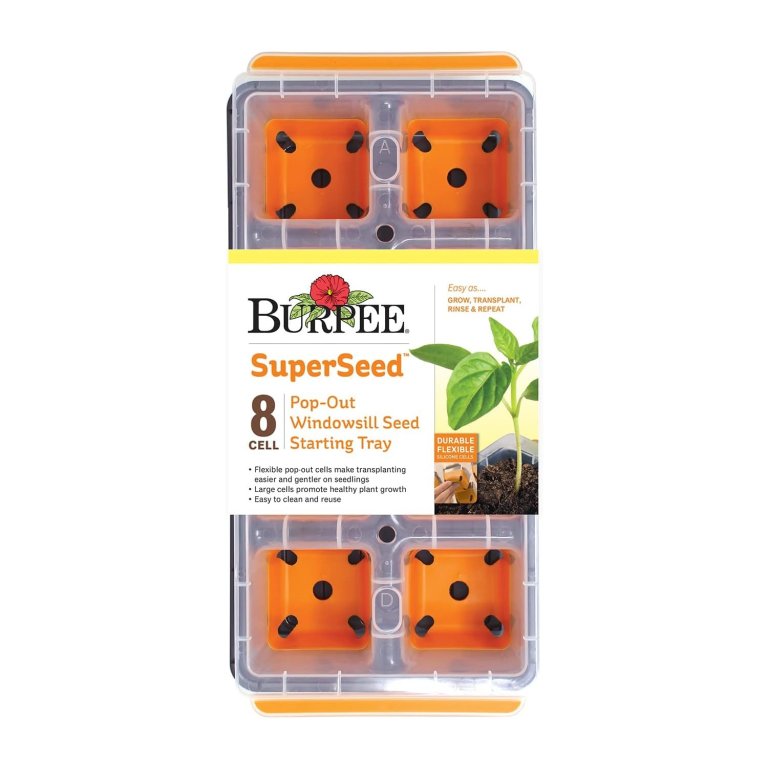
We may earn revenue from the products available on this page and participate in affiliate programs. Learn More ›
Starting plants from seed can be rewarding and cost-effective for gardening, and one of the most essential tools for this process is a seed starting tray. These trays provide a controlled environment that promotes germination and healthy root development, making them ideal for both beginners and experienced gardeners. While some opt to purchase seedlings or mature plants, starting from seed offers greater variety and control over the growing process.
Shopping for seed starting trays can be overwhelming due to the many options available. Trays come in different styles, materials, and price ranges, making it essential to find a high-quality product that suits your gardening needs. We tested multiple seed trays, evaluating durability, drainage, and ease of use. While we found several top-performing options, we also identified some standout choices we haven’t tested but highly recommend. Our top pick is the Vego Seed Starting Mixed Bundle, which excels in durability and seedling success.
To help you choose the right option, this guide highlights key features to consider and provides expert recommendations. Read on for the best seed starting trays to enhance your gardening success.
- BEST OVERALL: Vego Seed Starting Mixed Bundle
↓ Jump to Review - BEST BANG FOR THE BUCK: Jiffy 36 Peat Pellet Seed-Starting Greenhouse Kit
↓ Jump to Review - BEST FOR SMALL GARDENS: Gardener’s Supply GrowEase Seed Starter Kit
↓ Jump to Review - BEST KIT: Park Seed Bio Dome Seed-Starting System
↓ Jump to Review - BEST BIODEGRADABLE: CowPots 3-Inch Round Pot Planter
↓ Jump to Review - BEST LARGE BUNDLE: Bootstrap Farmer Ultimate Backyard Bundle Kit
↓ Jump to Review - BEST FOR SOIL BLOCKS: Bootstrap Farmer 1020 Mesh Deep Extra Strength Trays
↓ Jump to Review - BEST SELF-WATERING: Burpee 72-Cell Self-Watering Ultimate Grow System
↓ Jump to Review - BEST FOR WINDOW SILLS: Burpee SuperSeed Windowsill Seed Starting Tray
↓ Jump to Review - BEST BULK PACK:Bonviee 12-Pack Seed Starter Trays
↓ Jump to Review
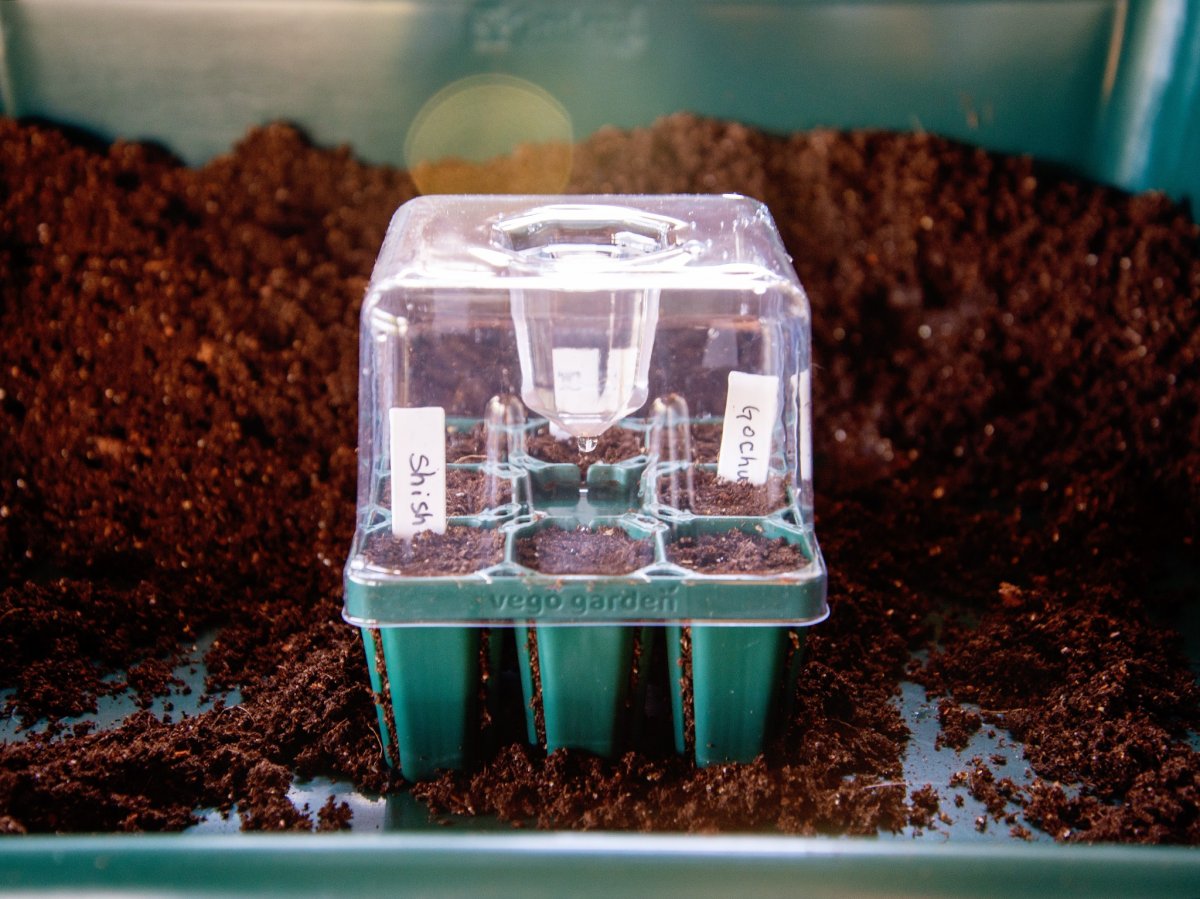
Seed Starting Tray Comparison Chart
| Material | Number of cells | Tray dimensions | |
| Vego Seed Starting Mixed Bundle | Tray: Injection-Molded PPE Plastic Lid: Food-grade PET plastic | 40 | Bottom water tray: 10” x 20” Jumbo seedling tray: 4.75″ L x 4.75″ L with four 2.5” x 2.5” cells Standard seedling tray: 4.75″ L x 4.75″ L with six 1″ x 1″ cells |
| Jiffy 36 Peat Pellet Seed-Starting Greenhouse Kit | Not Listed | 36 | 11” L x 11” L x 4.25” H (with dome) |
| Gardener’s Supply GrowEase Seed Starter Kit | BPA-free heavy-duty, recycled plastic | 24 | 4.75″ L x 9.25″ W x 2.25” H |
| Park Seed Bio Dome Seed-Starting System | Not listed | 80 | 14.88” L x 9.5” W x 2.25” H |
| CowPots 3-Inch Round Pot Planter | Recycled cow manure | 12 | 3.25″W x 3.38″H x 3.25″D |
| Bootstrap Farmer Ultimate Backyard Bundle Kit | Trays (#5 polypropylene); cell trays (#6 polystyrene) | (60) 6 Cell Plug Inserts(90) 3.3″ Pots | 6 cell tray: 5″ L x 3.3″ W x 25″ H, 3.3″ Seed Starting Pots: 3.3″ L X 3.3″ W X 4.3″ H |
| Bootstrap Farmer 1020 Mesh Deep Extra Strength Trays | Polypropylene (#5) plastic | N/A | 19.5″ L x 9.25″ W x 2.475″ H |
| Burpee 72-Cell Self-Watering Ultimate Grow System | Plastic | 72 | 10” L x 20” W x 5” H |
| Burpee SuperSeed Windowsill Seed Starting Tray | Plastic and Silicone | 8 | 11″ L X 5.25″ W X 2.25″ H |
| Bonviee 12-Pack Seed Starter Trays | Plastic | 60 | 6.1″L x 4.4″W x 4.4″H |

Our Top Picks
Now that you’ve learned a bit about grow trays, it’s time to start shopping. The following are our top picks for some of the best seedling starter trays for the home garden. ing. The following are our top picks for some of the best seedling starter trays for your home garden.
Best Overall
Vego Seed Starting Mixed Bundle Tray
What We Like
- Individual cell tray domes
- Durable materials
- Lids with irrigation chamber for gentle dripping
- Seedling trays have innovative watering channels
What We Don’t Like
- Expensive upfront investment
Specs
- Material Tray, injection-molded PPE plastic; lid, food-grade PET plastic
- Number of cells 40
- Tray dimensions Bottom water tray 20 inches long by 10 inches wide, cell trays vary
Our Ratings: Ease of Use 5/5; Design 5/5; Functionality 5/5; Value 5/5
When choosing seed-starting trays, we prioritize reusability, ventilation domes, and air-pruning slits for healthy roots before transplanting. The Vego Garden Seed Starting Mixed Bundle checks all the boxes. Its unique individual dome covers truly set it apart, allowing for better control over each seedling’s environment.
Made from durable injection-molded PPE plastic, the mixed bundle includes a bottom tray that is 10 by 20 inches, four jumbo trays (4.75 inches long by 4.75 inches wide with four 2.5-inch by 2.5-inch cells), and four standard trays (4.75 inches long by 4.75 inches wide with six 1-inch by 1-inch cells). Each tray has its own food-grade PET plastic dome, ensuring customizable humidity and protection.
Unlike traditional seed trays with a single large dome, this system prevents premature dome removal. Different plants germinate at different rates, and with individual covers, we could remove them only when needed, reducing the risk of fungal issues. The design also features drip-watering channels and domes with a refillable drip irrigation chamber for gentle, consistent moisture. Air-pruning slits enhance airflow and root health, while extra-wide holes allow for easy plug extraction—all professional-grade features for better plant growth.
The only downside is the cost, which may be steep for first-time gardeners. However, the company offers trays with the same features individually or in smaller bundles at lower cost to test out or gradually build a collection. We think the mixed bundle is a solid investment and might be the only seed-starting system needed for years.
Get the Vego Seed Starting Mixed Bundle Tray at Vego Garden.
Best Bang For The Buck
Jiffy 36 Peat Pellet Seed-Starting Greenhouse Kit
What We Like
- Affordable kit with essential seed-starting supplies
- Includes plantable peat pellets
- Comes with seedling fertilizer
What We Don’t Like
- Made from flimsy plastic
- No ventilation vents in dome
Specs
- Material Not listed
- Number of cells 36
- Tray dimensions 11 inches long by 11 inches wide by 4.25 inches high (with dome)
Our Ratings: Ease of Use 5/5; Design 3.6/5; Functionality 5/5; Value 5/5
We’ve used the Jiffy 36 Peat Pellet Seed-Starting Greenhouse Kit multiple times in our gardening journey, and it was actually the first kit we ever used when we started growing plants from seed. It’s an affordable option with nearly everything needed to get started—except the seeds. Plus, it’s widely available at big-box retailers, making it an easy choice for beginners.
The kit uses peat pellets as the growing medium, which are encased in a breathable, plantable mesh. Before planting, soak the compressed pellets in water until they fully expand. Once ready, plant the seeds, cover them with the included dome, and place the tray on a seed-starting mat or another warm surface to encourage germination. The kit even includes a small packet of starter fertilizer to use once seedlings emerge.
While we do like this seedling starter kit, we have a couple of complaints. First, the materials are flimsy. The plastic tray and dome may last a season or two at best, and unfortunately, they’re not easily recyclable. Second, the dome lacks ventilation vents, so users need to keep an eye on condensation and manually lift the lid to prevent fungal issues like damping off.
That said, those new to seed starting or looking for a budget-friendly option will find that the Jiffy 36 Peat Pellet Seed-Starting Greenhouse Kit is a solid choice to kick off the gardening season.
Get the Jiffy Seed Starting Kit at Amazon (2-pack), The Home Depot, or Ferry-Morse.
Best For Small Garden
Gardener’s Supply GrowEase Seed Starter Kit
What We Like
- Unique self-watering system ensures consistent moisture
- Made from durable, BPA-free plastic for long-term use
- Compact size perfect for limited space
What We Don’t Like
- No vent holes in dome
- Seedling removal can be tricky without extra tools
Specs
- Material BPA-free heavy-duty recycled plastic
- Number of cells 24
- Tray dimensions 4.75 inches long by 9.25 inches wide by 2.25 inches high
Our Ratings: Ease of Use 5/5; Design 4.6/5; Functionality 5/5; Value 5/5
The Gardener’s Supply GrowEase Seed Starter Kit is an excellent choice for new gardeners or anyone with limited space. We liked that it’s compact yet provides 24 planting spaces, making it prolific without taking up too much room. The self-watering system with the capillary mat and platform is a standout feature, helping to prevent overwatering—a common mistake for beginners. The kit is also made from durable, BPA-free plastic, ensuring it can be reused for multiple seasons.
However, there are a few drawbacks. The plastic cover isn’t as sturdy as the base and lacks vent holes, so users will have to lift it occasionally to provide airflow. While the planting cell tray is functional, it doesn’t have air-pruning strips, and the small base holes make seedling removal tricky. Gardener’s Supply sells seedling transplant tongs to help pop out seedlings, but that’s an extra purchase. Despite these minor issues, we still recommend it, especially for small-space gardeners who want a low-maintenance seed-starting solution.
Get the Gardener’s Supply GrowEase seed starting tray at Gardener’s Supply Company.
Best Kit
Park Seed Bio Dome Seed-Starting System
What We Like
- Kit provides everything users need to get started
- Bio sponges are less messy to use
- Double vent holes in the dome
What We Don’t Like
- Cost of replacement sponges
- Very bulky
Specs
- Material Plastic
- Number of cells 80
- Tray dimensions 14.88 inches long by 9.5 inches wide by 2.25 inches high
Our Ratings: Ease of Use 5/5; Design 4.6/5; Functionality 5/5; Value 4.6/5
The Park Seed Bio Dome Seed-Starting System is a well-designed, all-in-one kit that makes starting seeds simple and efficient. We appreciate that it includes everything users need, from the sturdy base and humidity dome to the Bio Sponges, which eliminate the mess of handling loose soil. The double vent holes on the dome are a great feature, allowing better control over humidity and airflow—something many seed-starting trays lack. We tested the kit with 80 planting cells, but there are options for smaller kits as well. All the kit sizes provide ample space for starting a variety of seeds, making it a solid choice for gardeners looking to grow multiple plants at once.
While the Bio Dome offers excellent functionality, there are a couple of drawbacks. The Bio Sponges are one-time use and need to be replaced seasonally, which is more expensive than traditional soil-based seed-starting methods. Additionally, while the polystyrene planting block is lightweight and easy to use, we have concerns about its long-term durability, especially with frequent reuse. The system is bulkier than standard seed trays, so gardeners with limited space may need to plan accordingly. That said, the ease of use, mess-free sponges, and adjustable ventilation make this an excellent option for beginners and experienced growers.
Get the Park Seed Bio Dome seed starting tray at Amazon or Park Seed.
Best Biodegradable
CowPots 3-Inch Round Pot Planter
What We Like
- Made from recycled, non-peat material
- Sturdy construction
- Available in multiple sizes
What We Don’t Like
- Slight manure scent when wet
- Can dry out faster than plastic pots
Specs
- Material Recycled cow manure
- Number of cells 12 per pack
- Tray dimensions 3.38 inches long by 3.25 inches wide by 3.25 inches high
Our Ratings: Ease of Use 5/5; Design 5/5; Functionality 5/5; Value 5/5
The CowPots Biodegradable Seed Starting System is an eco-friendly alternative to traditional plastic pots. Made from recycled, non-peat cow manure, these starter pots for seeds are fully biodegradable, breaking down during a single growing season. Despite their organic composition, they are surprisingly sturdy. Even after a full month of testing, filled with soil and consistent moisture, they held up well without breaking apart. However, since they are not plastic, the pots can dry out faster and will need consistent monitoring to avoid drying out completely and damaging fragile seedlings.
The only downside we noticed is that while CowPots are mostly odorless, they do have a slight manure scent when wet. It’s not overwhelming, but it’s something to be aware of, especially if using them indoors. Nonetheless, this is a small trade-off for a sustainable, peat-free option that eliminates plastic waste while providing healthy root growth for seedlings. For those looking for an environmentally friendly way to start seeds, CowPots is our top pick for the best biodegradable seed-starting system.
Get the Cow Pots seed starting system at Amazon.
Best Large Bundle
Bootstrap Farmer Ultimate Backyard Bundle Kit
What We Like
- Extremely durable
- Designed for professional use
- Color options available for easy plant organization
What We Don’t Like
- Higher upfront investment
Specs
- Material Trays, #5 polypropylene, cell trays, #6 polystyrene
- Number of cells 60 6-cell plug inserts, 90 3.3-inch pots
- Tray dimensions 21.1 inches long by 11 inches wide by 2.5 inches high
Our Ratings: Ease of Use 5/5; Design 5/5; Functionality 5/5; Value 4.6/5
We were introduced to Bootstrap Farmer’s products years ago and became immediate fans of their high-quality, professional-grade gardening supplies. Their Ultimate Backyard Bundle Kit is no exception—it’s built for durability and designed to withstand multiple growing seasons. Unlike flimsy seed-starting trays that crack or warp after one use, these are made from heavy-duty, BPA-free plastic that holds up under regular use. This kit is perfect for hobby farmers or serious gardeners who want large-scale seedling production without having to replace their setup every season. One standout feature is the option to choose tray colors, which allows for color-coding different plants—a simple but effective way to stay organized.
The only downside is the hefty upfront cost, but if for those serious about gardening, it’s absolutely worth it. The cost, when broken down, is about $36 per set, which is quite reasonable for something built to last. Compared to buying cheap trays that need replacing every year, this is a long-term, cost-effective solution despite the initial layout. With unmatched durability, professional-level design, and a complete set for large-scale growing, we highly recommend this kit for anyone looking for a long-lasting seed-starting system.
Get the Bootstrap Farmer seed starting system at Bootstrap Farmer.
Best For Soil Blocks
Bootstrap Farmer 1020 Mesh Deep Extra Strength Trays
What We Like
- Made from durable and recyclable plastic
- Designed to fit into standard 10×20-inch trays
- Inexpensive addition to seed starting system
What We Don’t Like
- Won’t retain moisture on its own, should be used with a tray
Specs
- Material #5 Polypropylene
- Number of cells N/A
- Tray dimensions 21 inches long by 10.75 inches wide by 2.475 inches high
Our Ratings: Ease of Use 5/5; Design 4.3/5; Functionality 5/5; Value 5/5
For those using the soil block method for seed starting, the Bootstrap Farmer 1020 Mesh Deep Extra Strength Tray is an excellent way to keep seedlings organized and properly hydrated. Since soil blocks lack plastic or peat containers to help maintain moisture, they require careful handling and bottom watering to prevent them from drying out. This mesh tray makes it easy to submerge and drain soil blocks with minimal disturbance, ensuring even moisture distribution while promoting healthy root development.
Like all Bootstrap Farmer products, this tray is built to last. Made from durable and recyclable #5 polypropylene plastic, it’s designed for multiple seasons of use without warping or cracking. While it’s ideal for soil blocks, it can also accommodate other seed-starting pots, making it a versatile addition to any propagation setup. The only downside is that, due to its mesh design, it doesn’t hold water on its own and should always be paired with a solid 10×20-inch tray. Fortunately, it fits perfectly inside a standard seedling tray for easy use. This tray is a durable and practical choice for seed-starters who rely on bottom watering for soil blocks or other containers.
More Great Options
We tested several seed-starting trays and researched additional options based on durability, drainage, and user feedback. Alongside our top picks, we found other highly rated trays for seeds that offer great features, including sturdy construction, excellent airflow, and compatibility with standard 10×20-inch trays.
Best Self-Watering
Burpee 72-Cell Self-Watering Ultimate Grow System
Pros
- Easy seed-starting system
- Consistent self-watering design
- Holds 72 seedlings
Cons
- May not accommodate larger seedlings
- Mat may need adjusting
Specs
- Material Plastic
- Number of cells 72
- Tray dimensions 10 inches long by 20 inches wide by 5 inches high
The Burpee 72-Cell Self-Watering Ultimate Growing System is designed to simplify seed starting by providing consistent moisture to seedlings. This system includes a 72-cell seed tray, a water reservoir, and a self-watering mat that helps regulate moisture levels. The capillary action of the mat ensures that seedlings receive just the right amount of water, preventing over- or under-watering. Additionally, the included clear humidity dome helps create an ideal environment for germination by maintaining warmth and moisture.
The 72-cell design allows gardeners to start a large number of plants in a compact space. The self-watering feature is especially beneficial for busy gardeners or beginners who may struggle with keeping seedlings consistently hydrated. However, while the system is convenient, some users may find that the self-watering mat requires occasional adjustments to function properly. Additionally, the cells may be on the smaller side for larger seedlings, requiring transplanting sooner. Despite these minor drawbacks, the Burpee 72-Cell Self-Watering Ultimate Growing System is a well-designed solution for anyone looking to streamline their seed-starting process.
Get the Burpee 72-cell seed starting tray kit at Amazon and Burpee.
Best For Window Sills
Burpee SuperSeed Windowsill Seed Starting Tray
Pros
- Compact, ideal for small spaces
- Extra-large cells for strong roots
- Silicone bottom for easy transplanting
Cons
- Limited to eight seedlings
Specs
- Material Plastic and silicone
- Number of cells 8
- Tray dimensions 11 inches long by 5.25 inches wide by 2.25 inches high
The Burpee SuperSeed Windowsill Seed Starting Tray Cell is an excellent option for gardeners with limited space, such as apartment dwellers using windowsills or small indoor setups. With only eight extra-large cells, this compact tray is perfect for starting a few strong seedlings without taking up too much room. Each cell is deep and wide, allowing for healthy root development, making it ideal for larger plants like tomatoes, peppers, and squash. The unique design features recessed watering channels that ensure even moisture distribution, reducing the risk of over- or under-watering. One of its standout features is the silicone cell bottom, which makes transplanting easy by gently pushing seedlings out without damaging roots. The included clear humidity dome helps maintain warmth and moisture, promoting strong germination even in cooler indoor environments.
While it doesn’t accommodate a large number of seedlings, it’s a great choice for those who want to grow a few strong plants in a manageable space. Its easy-to-use design makes it especially appealing to beginner gardeners or anyone looking for a simple, low-maintenance seed-starting solution.
Get the Burpee Superseed Windowsill seed starting tray at Amazon and Burpee.
Best Bulk Pack
Bonviee 12-Pack Seed Starter Trays
Pros
- Great value
- Adjustable humidity domes
- Includes base trays to prevent leaks
Cons
- Plastic is thinner than premium trays
Specs
- Material Plastic
- Number of cells 5 trays of 12
- Tray dimensions 6.9 inches long by 4.4 inches wide by 4.4 inches high
The Bonviee 12-Pack Seed Starter Trays is an excellent choice for starting a large number of seedlings at an affordable price. This bulk pack includes 12 trays, each with a 12-cell design, making it perfect for gardeners who need to grow multiple plants at once. Each tray features an adjustable humidity dome, allowing for precise moisture control to encourage strong germination. The included base trays help prevent leaks and keep watering mess-free, making them ideal for indoor use on windowsills, potting benches, or greenhouse setups.
The adjustable vents on the humidity domes allow for airflow control, preventing mold growth and improving seedling health. While the plastic construction is thinner than premium trays, this pack is an excellent value for home gardeners, schools, or community gardens needing an efficient seed-starting solution. A budget-friendly bulk option with solid features, the Bonviee Seed Starter Trays deliver great functionality without breaking the bank.
Get the Bonviee seed starting trays on Amazon.
Jump to Our Top Picks
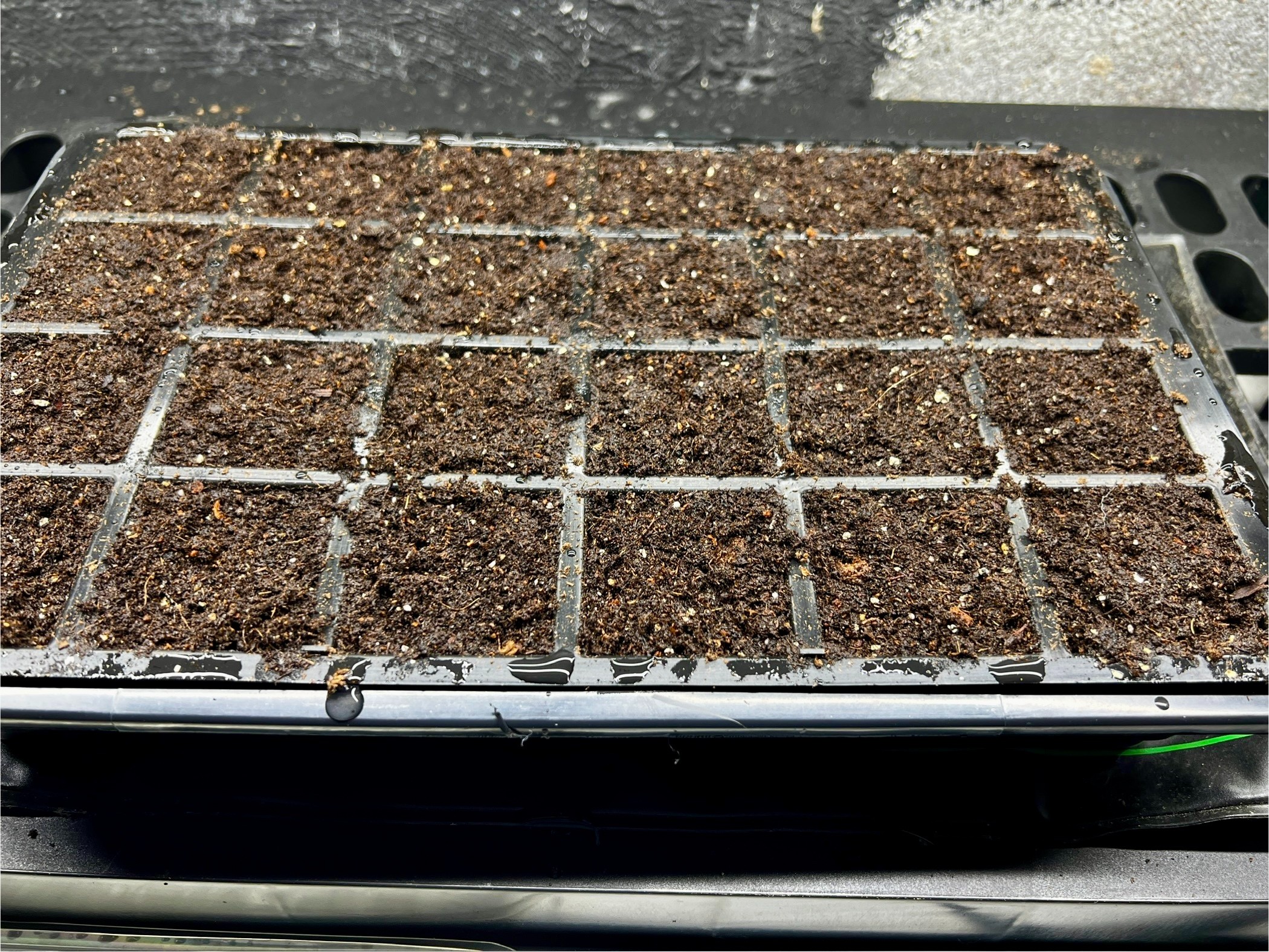
How We Chose and Tested the Best Seed Starting Trays
Years of hands-on gardening experience and extensive product testing went into curating this guide on the best seed starting trays. We started with a broad selection of over 25 seed tray options from reputable brands and narrowed them down based on durability, usability, and seedling performance. Our evaluation focused on durability and reusability, humidity dome effectiveness, and water absorption and retention—essential components for healthy plant development.
Our Selection Criteria
To ensure accurate, repeatable results, we tested each seed tray under consistent growing conditions. We used the same high-quality seed starting mix across all trays and evaluated them on the following criteria:
- Water Absorption and Retention:
- Each tray was filled with identical amounts of pre-moistened seed starting mix.
- We monitored how well the trays absorbed and retained moisture over a 7-day period.
- Trays that dried out too quickly or retained excessive water (leading to soggy soil) were rated lower.
- Humidity Dome Ventilation:
- Domes with vents were adjusted to test moisture control and airflow efficiency.
- We recorded condensation buildup and any signs of mold or fungal growth inside trays.
- Durability and Ease of Use:
- Each tray underwent multiple watering cycles and gentle flex testing to check for cracks, bends, or material degradation.
- We evaluated how easily seedlings could be removed from the trays without damaging the roots.
| Products tested | 7 |
| Time spent testing | 1 month |
| Tests performed | 3 |
| Price range | $6-$177 |
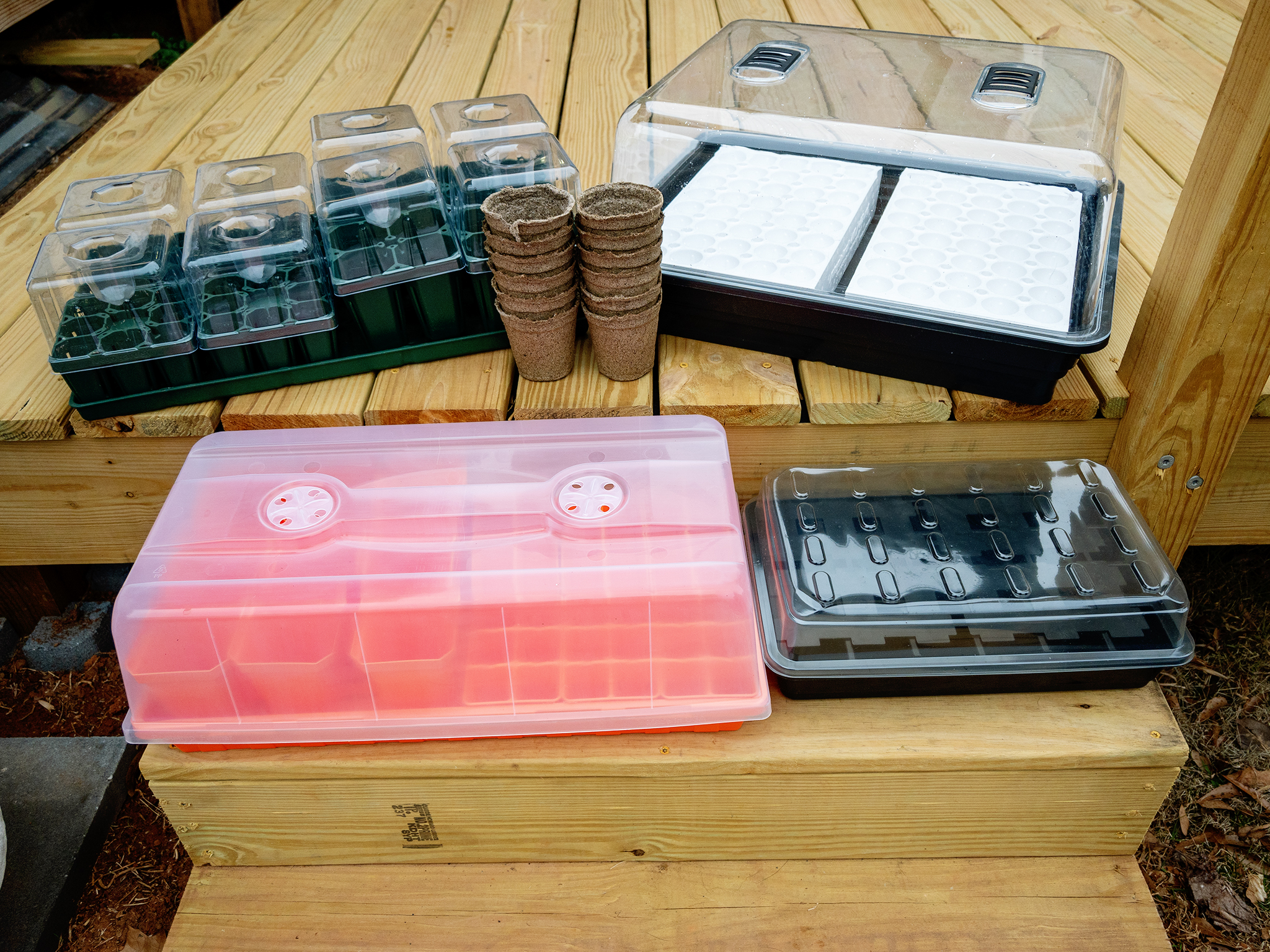
| Ease of Use | Design | Functionality | Value | |
| Vego Seed Starting Bundle | 5 | 5 | 5 | 5 |
| Jiffy 36 Peat Pellet Seed-Starting Greenhouse Kit | 5 | 3.6 | 5 | 5 |
| Gardener’s Supply GrowEase Seed Starter Kit | 5 | 4.6 | 5 | 5 |
| Park Seed Bio Dome Seed-Starting System | 5 | 4.6 | 5 | 4.6 |
| CowPots 3-Inch Round Pot Planter | 5 | 5 | 5 | 5 |
| Bootstrap Farmer Ultimate Backyard Bundle Kit | 5 | 5 | 5 | 4.6 |
| Bootstrap Farmer 1020 Mesh Deep Extra Strength Trays | 5 | 4.3 | 5 | 5 |
What to Consider When Choosing a Seed Starting Tray
Though it’s easy to assume that all plant starter trays offer similar performance, a number of factors affect their functionality. Keep reading to learn about some important features to consider when choosing the best seed starting supplies.
Material
A primary consideration when choosing a seed starter tray is the material. Generally speaking, seed trays usually fall into two categories: reusable or biodegradable.
- Reusable seed starter trays are a popular choice because they’re durable, lightweight, and made of reusable plastic. Since they can be used repeatedly, they’re economical, making them ideal for experienced gardeners who start seeds year after year. One downside is that the seedlings must be removed from the tray before they are planted. For organic vegetable gardening, opt for trays made from BPA-free plastic.
- Biodegradable seed planting trays are typically made from peat and can be planted directly into soil without removing the seedlings. The material degrades quickly once planted, allowing the plants’ roots to grow into the soil. This also helps to reduce transplant shock.
Capacity
A seed tray’s capacity is dependent on the number of cells it has. Small starter kits for seeds may only have four cells, while large models can have up to 70. Smaller trays can be arranged together in a variety of configurations to fit under grow lights, while larger trays are better suited to large growing stations.
If using natural light rather than grow lights, it’s best to opt for trays that are small enough to fit on a windowsill. Choose trays based on the capacity needed.
Cell Size and Depth
Another consideration when choosing planting trays is the size of each individual cell. Seed tray cells have a standard size of 1.5 inches long by 1.5 inches wide with a depth range from 1.5 to 2.5 inches. Some trays will intentionally vary to host larger plants or to accommodate seedlings that need to grow for a longer time prior to transplanting.
Seedling trays tend to be deeper and can accommodate more mature seedlings and plants with deeper root systems. It’s not advisable to choose a potting plant tray with cells deeper than 3 inches because they aren’t ideal for water drainage.
Accessories
While seed starting trays are sometimes sold without any extras, some include useful seed starting essentials.
- Domed lids are made from clear plastic and allow gardeners to monitor the plants’ progress while controlling the temperature and keeping the soil damp. Some domed lids are vented to provide additional humidity control.
- Base trays are designed to be used underneath cell trays and allow users to either catch water drainage or water the seeds from below.
- Watering mats function similarly to base trays but are designed to further aid in water being drawn up into the cell tray.
- Heating mats help to control the soil’s temperature and are particularly useful in cold climates.
- Labels come in handy to ensure growers can keep track of all the seeds they’ve planted.
Advantages of Using Seed Starting Trays
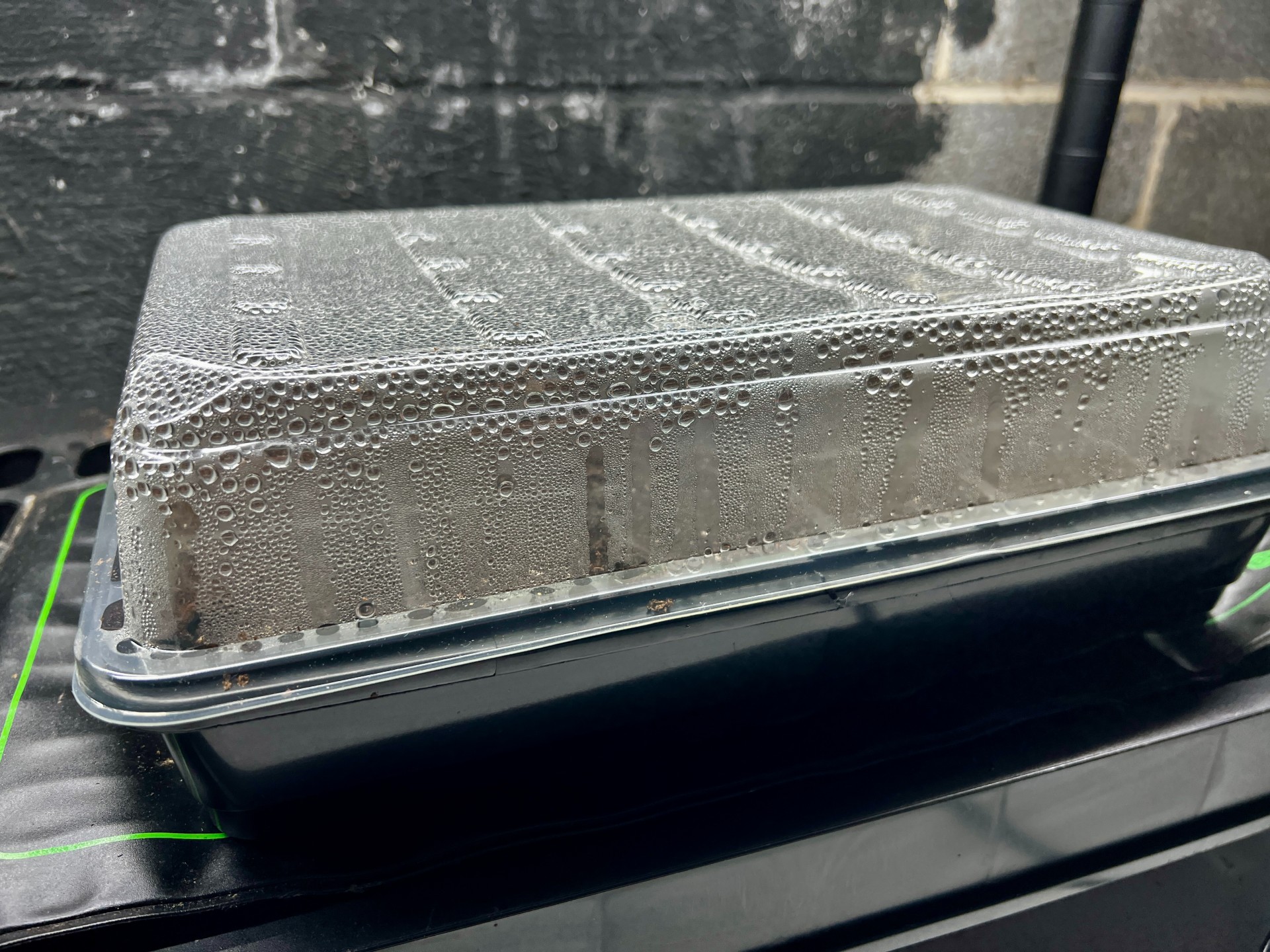
While it’s possible to germinate seeds in nearly any kind of container, using a seed starting tray makes the process simpler, tidier, and easier to maintain. Here are some advantages of using a seed starting tray.
- Seed trays line up the seedlings in rows, making them easier to heat or water evenly.
- Seed trays are easy to move around and can be brought outdoors once the weather is favorable.
- Seed trays feature drainage holes, which allow the soil or seed starting mix to drain effectively.
FAQs
While you now know more about choosing the best seed starting kit, you may still be looking for more information. Here are answers to some of the most frequently asked questions about seed starter trays.
The number of seedling trays needed depends on the number of seeds you wish to plant. It’s normal for some seeds to fail to germinate, so planting a few more than you’ll ultimately need is a good idea.
First, decide whether a reusable or biodegradable tray is preferable. Then, choose a tray with a size and capacity that best suits your needs.
A base tray should be placed under a seed starting tray to catch the water that drains out of the holes in the cell tray. The trays can also sit in a larger planter as long as the air can circulate freely.
To remove seedlings from a plastic tray for plants, turn the tray upside down and gently squeeze each cell to remove the seedling. Never pull on the seedling’s stem in order to remove it. If needed, use a butter knife to help detach the soil from the cell tray.
In order to help seeds germinate faster, some gardeners opt to soak their seeds in warm water for 24 hours before planting them. Also consider starting them indoors while waiting for the weather outside to warm.
The ideal temperature for seedlings varies based on the plant variety. Generally speaking, however, most seedlings thrive at temperatures between 65 and 75 degrees Fahrenheit.
Yes. Starting seeds is an economical choice because buying seeds is more cost-effective than buying seedlings or mature plants.
Meet the Tester
Debbie Wolfe is a seasoned writer and product tester with extensive experience in gardening and home improvement. She takes a hands-on, detailed approach to evaluating seed-starting trays, ensuring practical, well-researched recommendations for gardeners of all levels.
